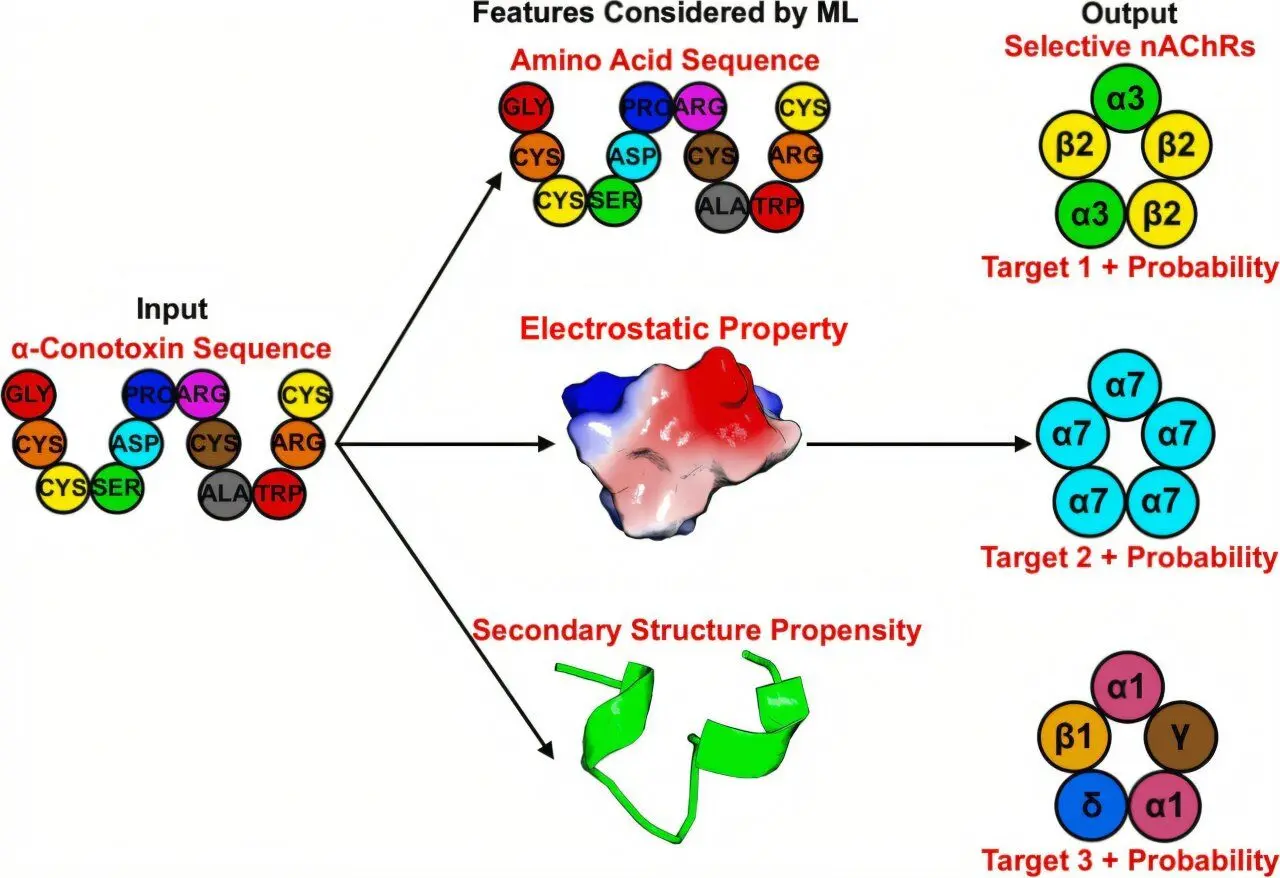AI Model Predicts Deadly Cone Snail Toxin Binding, Paving Way for Anti-Toxin Development
2 Sources
2 Sources
[1]
Machine learning model helps scientists understand deadly cone snail toxins
Marine cone snails are host to a family of dangerous neurotoxins. Very little is known about how those toxins interact with the human body, making this an area of interest for medical drug research and an area of concern in national security spaces. For the first time, a team at Los Alamos National Laboratory has successfully trained a machine learning model that predicts how alpha conotoxins bind to specific human receptor subtypes, which could help researchers develop lifesaving anti-toxins. "Because of the diversity and complexity of natural conotoxins, it is estimated that only 2% of them have been sequenced," said Gnana Gnanakaran, theoretical biologist at Los Alamos. "No antidotes exist for conotoxins, but by using machine learning to predict conotoxin binding, we now have the ability to develop tools to understand and respond to these threats." The deadly secretions issued by any one of the more than 800 cone snail species represent a conglomeration of more than 1 million natural conotoxins. The research team concentrated their machine learning work on alpha conotoxins, a particularly prevalent and deadly conotoxin family. The machine learning model the team implemented overcame the challenge of limited data to incorporate the alpha conotoxins' amino acid sequences, secondary structure propensities and electrostatic properties to successfully predict human receptors -- including subtypes of receptors -- the toxins would target. This is the first known machine learning model to accomplish that. The team, which in addition to Gnanakaran included lead author Hung Nguyen Do and biochemist Jessica Kubicek-Sutherland, published their results in ACS Chemical Neuroscience. Predicting subtype-specific targets Conus geographus, also known as the geography cone, lays claim to the distinction of deadliest cone snail. Its 65% fatality rate from a single sting is driven mostly by the activity of alpha conotoxins binding with human nicotinic acetylcholine receptors, which are integrated into the functioning of the human muscular system, nervous system and tissues. Binding to those receptors inhibits their functionality, with often fatal consequences. A challenge in predicting conotoxin binding is that very little data exists on receptor binding across the different conotoxin families. To understand which receptor subtypes are bonded to by alpha conotoxins, the research team developed and deployed two different neural network architectures to train their semi-supervised machine learning model. The team determined that the best performing semi-supervised machine learning classifier -- the most effective method of predicting the target receptor subtypes -- came from training the neural network architecture with a combination of dense and convolutional layers on amino acid sequences, secondary structure propensities and electrostatic properties. Next step: Making use of the predictions with experiments The team's next steps will be to take these predictions to the experimentation phase in a chemistry lab at Los Alamos, creating a real-world interface that can mimic the interactions and the binding of conotoxins. Such an interface could be made to act as an anti-toxin -- a useful tool given the possibility of bad actors developing synthetic neurotoxins. Neurotoxin-like agents could potentially be developed with synthetic peptides -- short chains of amino acids -- and would exhibit similar behavior and effects as seen with naturally occurring conotoxins. Unfortunately, developing synthetic peptides that behave similar to conotoxins requires significantly less understanding than developing an anti-toxin. But with a model in hand, researchers can apply their insight to that problem. "No one has asked these questions about target receptor subtype binding and gone this far," Kubicek-Sutherland said. "The experimentation phase of this will allow us to take the models developed through artificial intelligence tools and see if they are truly functional. That work is a critical step toward developing effective anti-toxins."
[2]
Machine Learning Model Helps Scientists Understand Deadly Cone Snail Toxins | Newswise
Newswise -- Marine cone snails are host to a family of dangerous neurotoxins. Very little is known about how those toxins interact with the human body, making this an area of interest for medical drug research and an area of concern in national security spaces. For the first time, a team at Los Alamos National Laboratory has successfully trained a machine learning model that predicts how alpha conotoxins bind to specific human receptor subtypes, which could help researchers develop lifesaving anti-toxins. "Because of the diversity and complexity of natural conotoxins, it is estimated that only 2% of them have been sequenced," said Gnana Gnanakaran, theoretical biologist at Los Alamos. "No antidotes exist for conotoxins, but by using machine learning to predict conotoxin binding, we now have the ability to develop tools to understand and respond to these threats." The deadly secretions issued by any one of the more than 800 cone snail species represent a conglomeration of more than 1 million natural conotoxins. The research team concentrated their machine learning work on alpha conotoxins, a particularly prevalent and deadly conotoxin family. The machine learning model the team implemented overcame the challenge of limited data to incorporate the alpha conotoxins' amino acid sequences, secondary structure propensities and electrostatic properties to successfully predict human receptors -- including subtypes of receptors -- the toxins would target. This is the first known machine learning model to accomplish that. The team, which in addition to Gnanakaran included lead author Hung Nguyen Do and biochemist Jessica Kubicek-Sutherland, published their results in ACS Chemical Neuroscience. Conus geographus, also known as the geography cone, lays claim to the distinction of deadliest cone snail. Its 65% fatality rate from a single sting is driven mostly by the activity of alpha conotoxins binding with human nicotinic acetylcholine receptors, which are integrated into the functioning of the human muscular system, nervous system and tissues. Binding to those receptors inhibits their functionality, with often fatal consequences. A challenge in predicting conotoxin binding is that very little data exists on receptor binding across the different conotoxin families. To understand which receptor subtypes are bonded to by alpha conotoxins, the research team developed and deployed two different neural network architectures to train their semi-supervised machine learning model. The team determined that the best performing semi-supervised machine learning classifier -- the most effective method of predicting the target receptor subtypes -- came from training the neural network architecture with a combination of dense and convolutional layers on amino acid sequences, secondary structure propensities and electrostatic properties. The team's next steps will be to take these predictions to the experimentation phase in a chemistry lab at Los Alamos, creating a real-world interface that can mimic the interactions and the binding of conotoxins. Such an interface could be made to act as an anti-toxin -- a useful tool given the possibility of bad actors developing synthetic neurotoxins. Neurotoxin-like agents could potentially be developed with synthetic peptides -- short chains of amino acids -- and would exhibit similar behavior and effects as seen with naturally occurring conotoxins. Unfortunately, developing synthetic peptides that behave similar to conotoxins requires significantly less understanding than developing an anti-toxin. But with a model in hand, researchers can apply their insight to that problem. "No one has asked these questions about target receptor subtype binding and gone this far," Kubicek-Sutherland said. "The experimentation phase of this will allow us to take the models developed through artificial intelligence tools and see if they are truly functional. That work is a critical step toward developing effective anti-toxins." Paper: "Prediction of Specificity of α‑Conotoxins to Subtypes of Human Nicotinic Acetylcholine Receptors with Semi-Supervised Machine Learning." ACS Chemical Neuroscience. DOI: 10.1021/acschemneuro.4c00760 Funding: This work was supported by the Defense Threat Reduction Agency at the U.S. Department of Defense.
Share
Share
Copy Link
Scientists at Los Alamos National Laboratory have developed a machine learning model that predicts how alpha conotoxins from marine cone snails bind to specific human receptor subtypes, potentially leading to the development of life-saving anti-toxins.
Breakthrough in Conotoxin Research
Scientists at Los Alamos National Laboratory have made a significant advancement in understanding deadly cone snail toxins using machine learning. The research team, led by theoretical biologist Gnana Gnanakaran, has successfully trained an AI model to predict how alpha conotoxins bind to specific human receptor subtypes
1
.The Deadly World of Cone Snails
Marine cone snails, comprising over 800 species, produce a vast array of neurotoxins. These toxins, collectively known as conotoxins, represent a conglomeration of more than 1 million natural compounds. The most lethal among them is the geography cone (Conus geographus), which boasts a staggering 65% fatality rate from a single sting
2
.AI Model Overcomes Data Limitations
The research team focused on alpha conotoxins, a particularly prevalent and deadly family of these toxins. Despite the limited available data, the machine learning model successfully incorporated the alpha conotoxins' amino acid sequences, secondary structure propensities, and electrostatic properties to predict their target human receptors, including specific subtypes
1
.
Source: Phys.org
Innovative Machine Learning Approach
To achieve this breakthrough, the team developed and deployed two different neural network architectures for their semi-supervised machine learning model. The most effective method for predicting target receptor subtypes came from training the neural network architecture with a combination of dense and convolutional layers
2
.Implications for Anti-Toxin Development
This research has significant implications for both medical drug research and national security. Currently, no antidotes exist for conotoxins, and only about 2% of natural conotoxins have been sequenced. The new AI model provides a powerful tool for understanding and potentially responding to these threats
1
.Related Stories
Future Directions and Potential Applications
The team's next steps involve taking these predictions to the experimentation phase in a chemistry lab at Los Alamos. They aim to create a real-world interface that can mimic the interactions and binding of conotoxins, potentially leading to the development of an anti-toxin
2
.Addressing Synthetic Neurotoxin Concerns
The research also has implications for addressing potential threats from synthetic neurotoxins. Bad actors could potentially develop neurotoxin-like agents using synthetic peptides that mimic conotoxins. However, the insights gained from this AI model could be applied to counter such threats
1
.This groundbreaking research, published in ACS Chemical Neuroscience, represents a critical step towards developing effective anti-toxins and understanding the complex world of marine neurotoxins. The work was supported by the Defense Threat Reduction Agency at the U.S. Department of Defense, highlighting its significance in both scientific and national security contexts
2
.References
Summarized by
Navi
Related Stories
AI-Designed Proteins Show Promise in Neutralizing Deadly Snake Venom Toxins
16 Jan 2025•Science and Research

AI Uncovers Hundreds of Potential Antibiotics in Animal Venom, Offering New Hope Against Antibiotic Resistance
15 Jul 2025•Science and Research

AI Model Revolutionizes Drug Safety by Predicting Human Toxicity Before Clinical Trials
07 Nov 2025•Health

Recent Highlights
1
Google launches Gemini 3 Flash as default AI model, delivering speed with Pro-grade reasoning
Technology

2
OpenAI launches GPT Image 1.5 as AI image generator war with Google intensifies
Technology

3
OpenAI launches ChatGPT app store, opening doors for third-party developers to build AI-powered apps
Technology





